 |
 |
 |
 |
 |
 |
 |
 |
 |
 |
Home > Environmental Issues > Article > |
|
 |
|
Four fishing companies propose token measure, to stop Indian Ocean bottom trawling7 July 2006Four international fishing companies, including the New Zealand company Sealord, have announced a proposal to voluntarily stop bottom trawl fishing in areas of the Southern Indian Ocean. This is a feeble attempt that cannot be seriously regarded as a conservation measure. It is obviously intended to divert attention away from the company's destructive fishing practices during the last 25 years, in the face of world concern over the loss of deepsea biodiversity. Sealord must be increasingly concerned about the growing number countries that are calling for a United Nations global moratorium on bottom trawling. It is not likely that the 309,000 sq.km area of Indian Ocean seafloor where it is proposed to stop trawling is still vulnerable to bottom trawling damage. Habitat has already been destroyed. There have recently been only four or five vessels fishing in the area. From 1999 to 2001 nearly fifty vessels from up to 15 countries were bottom trawling in the Southern Indian Ocean. |
|
 |
But catches of orange roughy (shown left) and alfonsino quickly peaked in 2000 and then went into rapid decline. |
With only a half dozen vessels fishing for orange roughy and alfonsino in the Southern Indian Ocean in 2002, it is apparent that the fishery collapsed in just three years. |
|
|
One good result from the Sealord proposal is that the companies practicing bottom trawling are now publicly acknowledging the destruction of seafloor, by voluntarily deciding not to trawl in some areas. The Minister of Fisheries, Jim Anderton said "New Zealand would support this proposal as an interim measure under the Southern Indian Ocean Fisheries Agreement, on the basis that the proposal is subjected to independent scientific assessment, and modified if deemed appropriate". The Minister believes these are "definitely constructive and positive steps forward". They are grossly insufficient steps to solving a major worldwide problem. Only a moratorium on bottom trawling can effectively allow the time to make assessments and establish management controls for sensitive deepsea ecosystems. Green Party Fisheries Spokesperson Metiria Turei said "... it is hard to get excited about this announcement when you consider that the area in question is already severely overfished. It is not much of a sacrifice to cease fishing of an area with no fish left in it ..." |
|
 |

|
Similarities of bottom trawling closuresIn February the Minister of Fisheries announced a draft accord with New Zealand deepwater fishing companies to close 1.2 million sq.km, which is 31 percent of New Zealand's Exclusive Economic Zone (EEZ), to bottom trawling and dredging. The fishing companies will have no interest in many of the closed areas, because they have never been fishing grounds, or have already been overfished. The seafloor of many locations is too deep, too steep or too rocky for bottom trawling gear to traverse. There is a reason why the New Zealand bottom trawling fleet moved on to high seas areas such as the Southern Indian Ocean. There is a striking resemblance between the closures in the New Zealand EEZ and the Southern Indian Ocean - bottom trawling is being stopped in unfishable areas. But a large area is still open in the EEZ, and the New Zealand fishing industry is still bottom trawling on the high seas. It is cause to wonder who is governing who, when the fishing industry makes proposals for the protection of untrawlable areas, and the Minister of Fisheries welcomes them as "significant progress". |
||||||
|
||||||
|
||||||
 NZ government’s stance on bottom trawling in international waters is weak and
ineffective .....TAKE ACTION
NZ government’s stance on bottom trawling in international waters is weak and
ineffective .....TAKE ACTION
